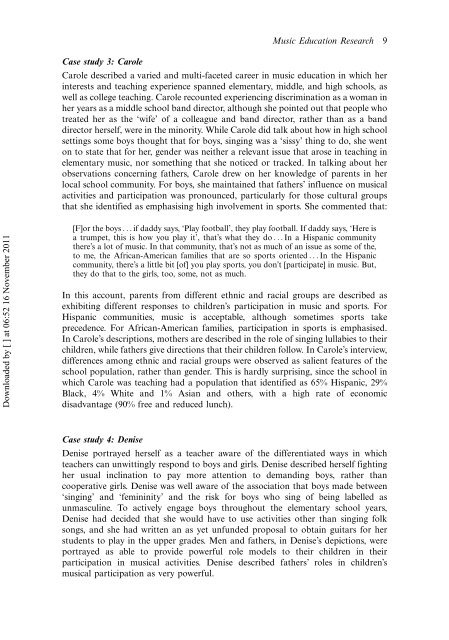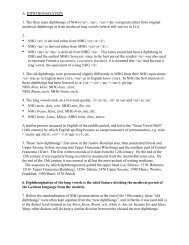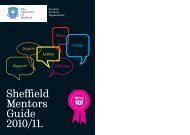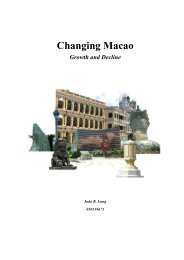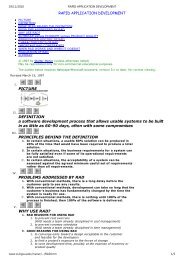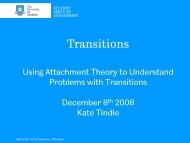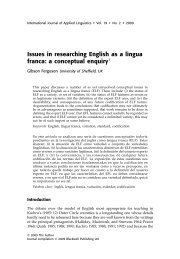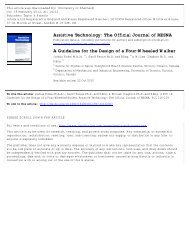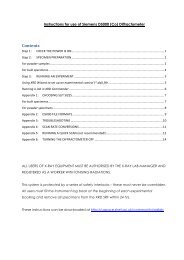Music teachers' constructions of gender in elementary education
Music teachers' constructions of gender in elementary education
Music teachers' constructions of gender in elementary education
You also want an ePaper? Increase the reach of your titles
YUMPU automatically turns print PDFs into web optimized ePapers that Google loves.
Downloaded by [ ] at 06:52 16 November 2011<br />
<strong>Music</strong> Education Research 9<br />
Case study 3: Carole<br />
Carole described a varied and multi-faceted career <strong>in</strong> music <strong>education</strong> <strong>in</strong> which her<br />
<strong>in</strong>terests and teach<strong>in</strong>g experience spanned <strong>elementary</strong>, middle, and high schools, as<br />
well as college teach<strong>in</strong>g. Carole recounted experienc<strong>in</strong>g discrim<strong>in</strong>ation as a woman <strong>in</strong><br />
her years as a middle school band director, although she po<strong>in</strong>ted out that people who<br />
treated her as the ‘wife’ <strong>of</strong> a colleague and band director, rather than as a band<br />
director herself, were <strong>in</strong> the m<strong>in</strong>ority. While Carole did talk about how <strong>in</strong> high school<br />
sett<strong>in</strong>gs some boys thought that for boys, s<strong>in</strong>g<strong>in</strong>g was a ‘sissy’ th<strong>in</strong>g to do, she went<br />
on to state that for her, <strong>gender</strong> was neither a relevant issue that arose <strong>in</strong> teach<strong>in</strong>g <strong>in</strong><br />
<strong>elementary</strong> music, nor someth<strong>in</strong>g that she noticed or tracked. In talk<strong>in</strong>g about her<br />
observations concern<strong>in</strong>g fathers, Carole drew on her knowledge <strong>of</strong> parents <strong>in</strong> her<br />
local school community. For boys, she ma<strong>in</strong>ta<strong>in</strong>ed that fathers’ <strong>in</strong>fluence on musical<br />
activities and participation was pronounced, particularly for those cultural groups<br />
that she identified as emphasis<strong>in</strong>g high <strong>in</strong>volvement <strong>in</strong> sports. She commented that:<br />
[F]or the boys ...if daddy says, ‘Play football’, they play football. If daddy says, ‘Here is<br />
a trumpet, this is how you play it’, that’s what they do ...In a Hispanic community<br />
there’s a lot <strong>of</strong> music. In that community, that’s not as much <strong>of</strong> an issue as some <strong>of</strong> the,<br />
to me, the African-American families that are so sports oriented ...In the Hispanic<br />
community, there’s a little bit [<strong>of</strong>] you play sports, you don’t [participate] <strong>in</strong> music. But,<br />
they do that to the girls, too, some, not as much.<br />
In this account, parents from different ethnic and racial groups are described as<br />
exhibit<strong>in</strong>g different responses to children’s participation <strong>in</strong> music and sports. For<br />
Hispanic communities, music is acceptable, although sometimes sports take<br />
precedence. For African-American families, participation <strong>in</strong> sports is emphasised.<br />
In Carole’s descriptions, mothers are described <strong>in</strong> the role <strong>of</strong> s<strong>in</strong>g<strong>in</strong>g lullabies to their<br />
children, while fathers give directions that their children follow. In Carole’s <strong>in</strong>terview,<br />
differences among ethnic and racial groups were observed as salient features <strong>of</strong> the<br />
school population, rather than <strong>gender</strong>. This is hardly surpris<strong>in</strong>g, s<strong>in</strong>ce the school <strong>in</strong><br />
which Carole was teach<strong>in</strong>g had a population that identified as 65% Hispanic, 29%<br />
Black, 4% White and 1% Asian and others, with a high rate <strong>of</strong> economic<br />
disadvantage (90% free and reduced lunch).<br />
Case study 4: Denise<br />
Denise portrayed herself as a teacher aware <strong>of</strong> the differentiated ways <strong>in</strong> which<br />
teachers can unwitt<strong>in</strong>gly respond to boys and girls. Denise described herself fight<strong>in</strong>g<br />
her usual <strong>in</strong>cl<strong>in</strong>ation to pay more attention to demand<strong>in</strong>g boys, rather than<br />
cooperative girls. Denise was well aware <strong>of</strong> the association that boys made between<br />
‘s<strong>in</strong>g<strong>in</strong>g’ and ‘fem<strong>in</strong><strong>in</strong>ity’ and the risk for boys who s<strong>in</strong>g <strong>of</strong> be<strong>in</strong>g labelled as<br />
unmascul<strong>in</strong>e. To actively engage boys throughout the <strong>elementary</strong> school years,<br />
Denise had decided that she would have to use activities other than s<strong>in</strong>g<strong>in</strong>g folk<br />
songs, and she had written an as yet unfunded proposal to obta<strong>in</strong> guitars for her<br />
students to play <strong>in</strong> the upper grades. Men and fathers, <strong>in</strong> Denise’s depictions, were<br />
portrayed as able to provide powerful role models to their children <strong>in</strong> their<br />
participation <strong>in</strong> musical activities. Denise described fathers’ roles <strong>in</strong> children’s<br />
musical participation as very powerful.


